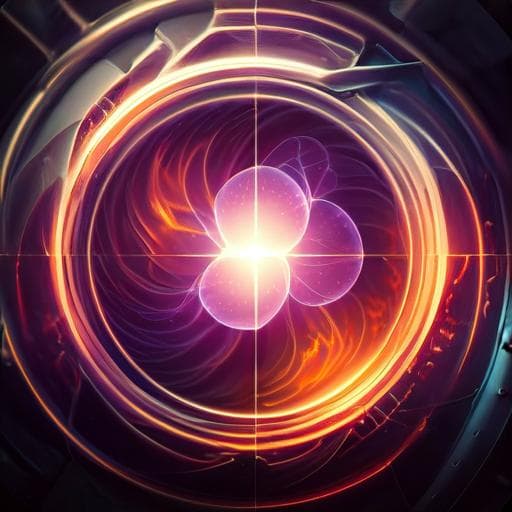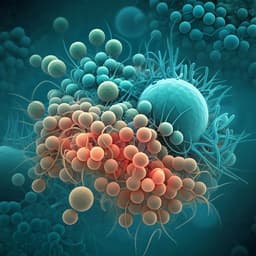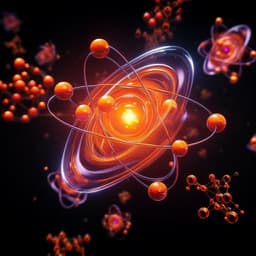
Physics
Chiral quantum heating and cooling with an optically controlled ion
J. Bu, J. Zhang, et al.
This groundbreaking research by Jin-Tao Bu and colleagues explores chiral quantum heating and refrigeration, revealing how dynamically encircling a closed loop near a Liouvillian exceptional point influences heat dynamics. The study delves into the intriguing roles of adiabaticity breakdown and the Landau-Zener-Stückelberg process, enhancing our understanding of non-Hermitian systems and quantum thermodynamics.
~3 min • Beginner • English
Introduction
Quantum heat engines (QHEs) convert heat from thermal reservoirs into work using quantum working media, and have been implemented in systems such as trapped ions and spin ensembles, with proposals in superconducting circuits and optomechanics. Quantum refrigerators (QRs) remove heat from a cold bath using external work and have been realized with superconducting qubits, quantum dots, and trapped ions. Non-Hermitian dynamics with exceptional points (EPs) has revealed exotic features; however, Hamiltonian EPs do not capture quantum jumps and noise. Instead, the Liouvillian formalism is needed for open quantum systems, defining Liouvillian EPs (LEPs) as eigenvalue degeneracies of the Liouvillian superoperator. LEPs can optimize QHE dynamics towards steady states, enhance efficiency, and endow topological properties, but have remained largely unexplored in quantum thermodynamics. While dynamical encircling of Hamiltonian EPs can yield chiral state transfer even without enclosing the EP, similar Riemann-surface landscapes around LEPs imply non-trivial state transfer when encircling or operating near LEPs. The outcome of parametric loops depends on topology, trajectory, speed, and Landau-Zener-Stückelberg (LZS) phases. This work experimentally demonstrates chiral behavior in a trapped-ion qubit without encircling LEPs by performing parametric loops in their vicinity, realizing chiral quantum heating and refrigeration cycles; non-adiabaticity and LZS processes are shown to be essential.
Literature Review
The paper situates the study within prior work on quantum heat engines and refrigerators realized in trapped ions, spin ensembles, superconducting qubits, and quantum dots, and highlights proposed implementations in superconducting circuits and optomechanical systems. It reviews non-Hermitian physics and exceptional points (EPs), distinguishing Hamiltonian EPs, which neglect quantum jumps, from Liouvillian EPs (LEPs) that capture full open-system dynamics including decoherence and quantum jumps. Prior studies showed chiral behavior from dynamical EP encirclement and even from loops in the EP vicinity in classical systems; analogous LEP Riemann-surface structures suggest similar phenomena in quantum systems. Experimental challenges include realizing counterintuitive chiral behavior in quantum systems without encircling LEPs, with outcomes sensitive to loop topology, trajectory, evolution speed, LZS phases, and coherence, affecting network and efficiency of QHEs.
Methodology
Platform: A single ultracold 40Ca+ ion is confined in a linear Paul trap with axial and radial frequencies ωz/2π = 1.01 MHz and ωr/2π = 1.2 MHz. An axial magnetic field of 0.6 mT splits Zeeman sublevels. Levels |2S1/2, mj=+1/2⟩ ≡ |g⟩, |2D5/2, mj=+5/2⟩ ≡ |e⟩, and |2P3/2, mj=+3/2⟩ ≡ |p⟩ are used. After Doppler and resolved-sideband cooling, the z-mode mean phonon number is much less than 1 (Lamb-Dicke parameter ~0.11).
Effective two-level system: By driving the dipole transition |e⟩↔|p⟩ with 854 nm (introducing a controlled decay) and the 729 nm quadrupole transition, the three-level system reduces to an effective two-level qubit with tunable Rabi frequency Ω and effective decay rate γeff = 2Ω2/Γ (for Ω ≪ Γ), enabling full control to realize parametric loops that may or may not encircle the LEP.
Dynamics and LEP: The evolution obeys the Lindblad master equation ρ̇ = Lρ = −i[Heff,ρ] + (2σ+ ρ σ− − σ−σ+ ρ − ρ σ−σ+), with Heff = Δ|e⟩⟨e| + Ω(|e⟩⟨g| + |g⟩⟨e|), where Δ is the detuning of the 729 nm drive from resonance. At Δ=0, Liouvillian eigenvalues are λ1 = 0, λ2 = −γeff/2, λ3 = −3γeff/4, λ4 = (−3γeff+ξ)/4 with ξ = √(γeff2 − 16Ω2). λ3 and λ4 coalesce at γeff = 4Ω, yielding a second-order LEP. For γeff > 4Ω (weak coupling), λ3,4 are real (broken phase, non-oscillatory exponential decay). For γeff < 4Ω (strong coupling), they are complex conjugates (exact phase, oscillatory dynamics). The LEP acts as a critical damping point separating these regimes.
Thermodynamic cycles and strokes: The qubit is the working substance. Thermal baths are provided by the 729 nm drive and the environment. Work is performed by varying Δ in Heff, while changes in |e⟩ population correspond to heat absorption (increase) or release (decrease). The cycle consists of two iso-decay (γeff fixed, Δ varied) and two isochoric (Δ,Ω fixed; γeff varied) strokes. Iso-decay strokes shift the energy splitting (expansion/compression); isochoric strokes rapidly reach near steady states and change |e⟩ population for heating or cooling by varying γeff.
Parametric loops near the LEP: The ion is initialized in |+⟩=(|e⟩+|g⟩)/√2 or |−⟩=(|e⟩−|g⟩)/√2 at Δ=0 (mid-points of iso-decay strokes). Δ is restricted to be below half the vibrational frequency. Closed loops in (Δ,γeff) space that do not encircle the LEP are executed via five strokes: an iso-decay compression (A→B, Δ:0→Δmax at γmin), an isochoric cooling (B→C, γeff:γmin→γmax at Δmax), an iso-decay expansion (C→D, Δ:Δmax→Δmin at γmax), an isochoric heating (D→E, γeff:γmax→γmin at Δmin), and a final iso-decay compression (E→A, Δ:Δmin→0 at γmin). Clockwise (CW) loops execute the reverse order. Landau-Zener and Landau-Zener-Stückelberg (LZS) transitions occur during detuning sweeps, accumulating phases and inducing non-adiabatic state transfer.
Experimental parameters (representative): Ω/2π = 120 kHz; Δmin/2π = −400 kHz, Δmax/2π = +400 kHz; γmin = 0 kHz, γmax = 1.45 MHz. Stroke durations: T1 = T5 = 6 μs, T3 = 12 μs, T2 = T4 = 150 μs. Fidelities and populations are measured over 10,000 repetitions; master-equation simulations are used for comparison.
Work evaluation: The network is evaluated from Wnet = ∫0T dt Tr[ρ(t) Δ(t)|e⟩⟨e|], considering only iso-decay strokes (isochoric strokes do no work). Comparison of mean |e⟩ populations during expansion versus compression identifies QHE (positive network) versus QR (negative).
Key Findings
- First experimental demonstration of chiral quantum heating and refrigeration in a quantum system by dynamically executing closed loops in the vicinity of a Liouvillian exceptional point (LEP) without encircling it, using a single trapped-ion qubit.
- Chirality: The final state depends only on the loop direction and not on the initial state. CW loops end at |ψ+⟩, CCW loops end at |ψ−⟩, regardless of starting from |ψ+⟩ or |ψ−⟩, evidencing asymmetric mode conversion (chiral state transfer).
- Role of non-adiabaticity and LZS: Breakdown of adiabaticity and Landau-Zener-Stückelberg (LZS) interference during detuning sweeps are essential to the observed chiral dynamics and thermodynamic cycle outcomes.
- Quantum heating (QHE) versus cooling (QR): For the CW loop starting at |ψ+⟩, isochoric strokes do no work; the two iso-decay expansions have higher mean |e⟩ population than the compression, yielding positive Wnet (QHE). For the CCW loop starting at |ψ−⟩, the two compressions have higher mean |e⟩ population than the expansion, yielding negative Wnet (QR).
- Experimental details supporting findings: Initial preparation fidelity for |+⟩ was ⟨+|ρ|+⟩ ≈ 0.985. Representative parameters: Ω/2π = 120 kHz, Δmin/2π = −400 kHz, Δmax/2π = +400 kHz, γmin = 0 kHz, γmax = 1.45 MHz; stroke durations T1=T5=6 μs, T3=12 μs, T2=T4=150 μs. The loops do not encircle the LEP but lie near it.
- LEP physics: The Liouvillian spectrum exhibits a second-order LEP at γeff=4Ω (Δ=0), separating exact (oscillatory) and broken (non-oscillatory) phases, providing the non-Hermitian landscape underpinning the chiral response.
Discussion
The study addresses how non-Hermitian features of open quantum systems, specifically Liouvillian exceptional points, influence thermodynamic cycles. By implementing closed parametric loops near an LEP in a trapped-ion qubit, the authors observe chiral state transfer where the loop direction alone determines the final state. This establishes a direct connection between chirality in non-Hermitian dynamics and operational modes of quantum heat engines and refrigerators. The findings show that even without enclosing an LEP, the Riemann-surface structure of the Liouvillian spectrum and the associated breakdown of adiabaticity lead to asymmetric mode conversion, with Landau-Zener-Stückelberg phases playing a decisive role. Consequently, CW and CCW loops realize QHE and QR behaviors (positive and negative network), respectively. This demonstrates that LEP-related topology and non-adiabatic dynamics can be harnessed to engineer thermodynamic functionality in quantum devices. The results provide experimental evidence bridging non-Hermitian physics, chirality, and quantum thermodynamics, reinforcing predictions that LEPs can optimize QHE performance and impart topological characteristics.
Conclusion
The work demonstrates chiral quantum heating and cooling in a single trapped-ion platform by executing closed parametric loops near a Liouvillian exceptional point without encircling it. The loop direction dictates the final state independent of the initial state, enabling QHE (positive net work) or QR (negative net work) behavior. The essential mechanisms are adiabaticity breakdown and Landau-Zener-Stückelberg interference governed by the non-Hermitian Liouvillian landscape. These observations deepen understanding of chiral and topological features in non-Hermitian open quantum systems and open opportunities to explore the interplay between chirality and quantum thermodynamics. Potential future directions include direct encirclement of LEPs, systematic mapping of chiral thermodynamic responses versus loop geometry and speed, extension to multi-level/multi-qubit systems, and leveraging LEP topology for optimized quantum thermal machines.
Limitations
Related Publications
Explore these studies to deepen your understanding of the subject.







